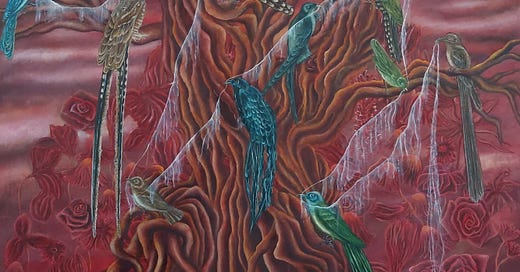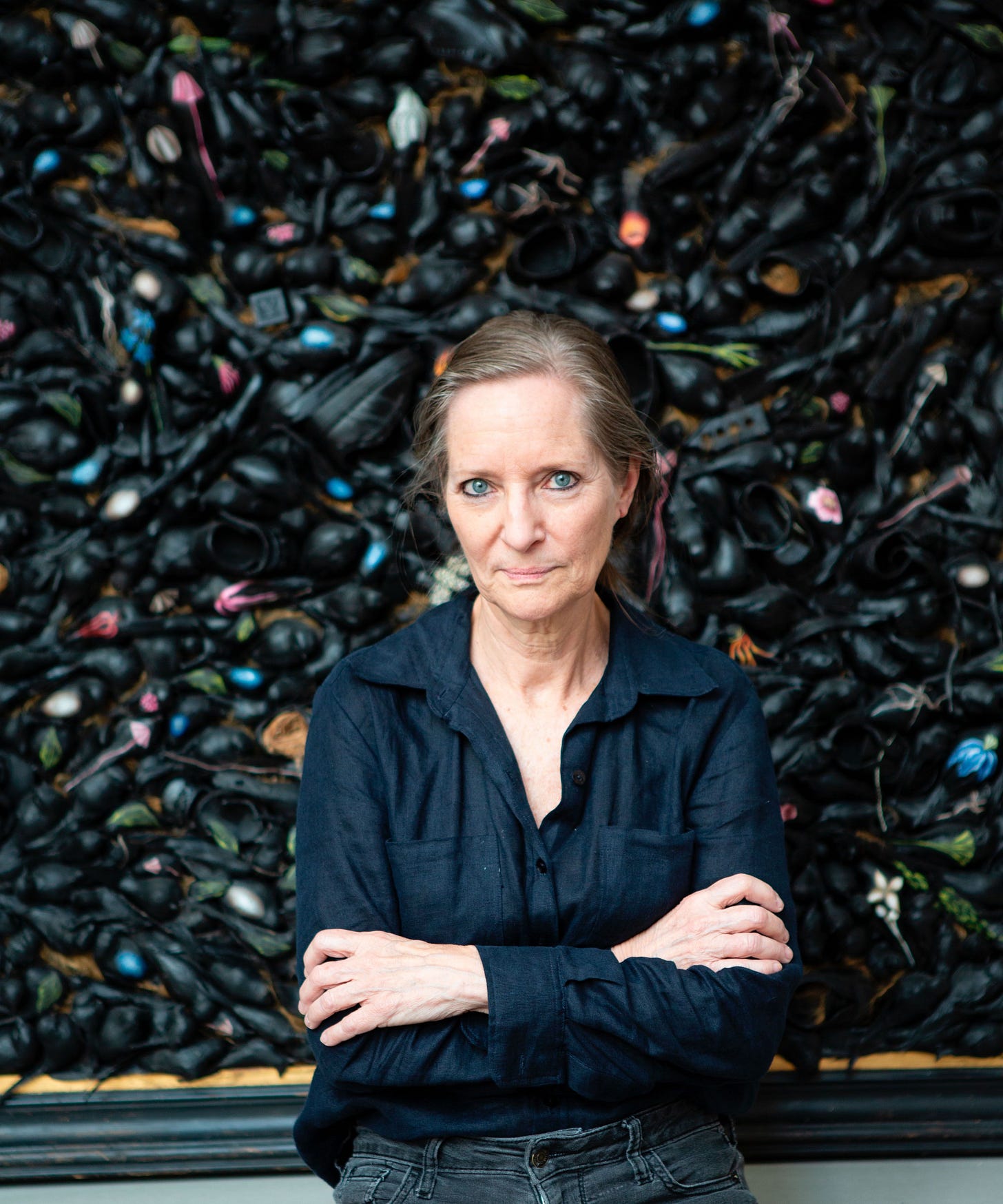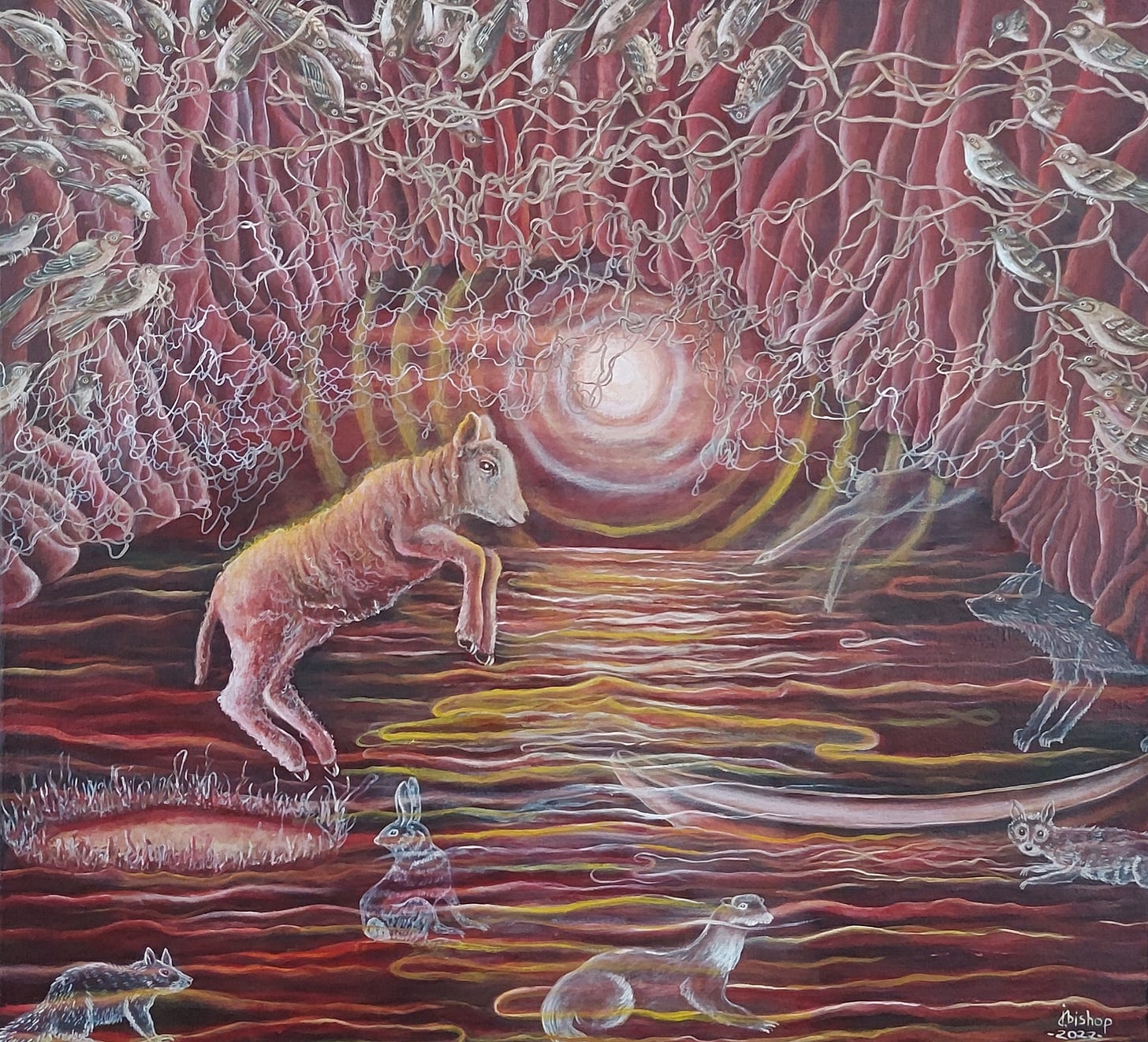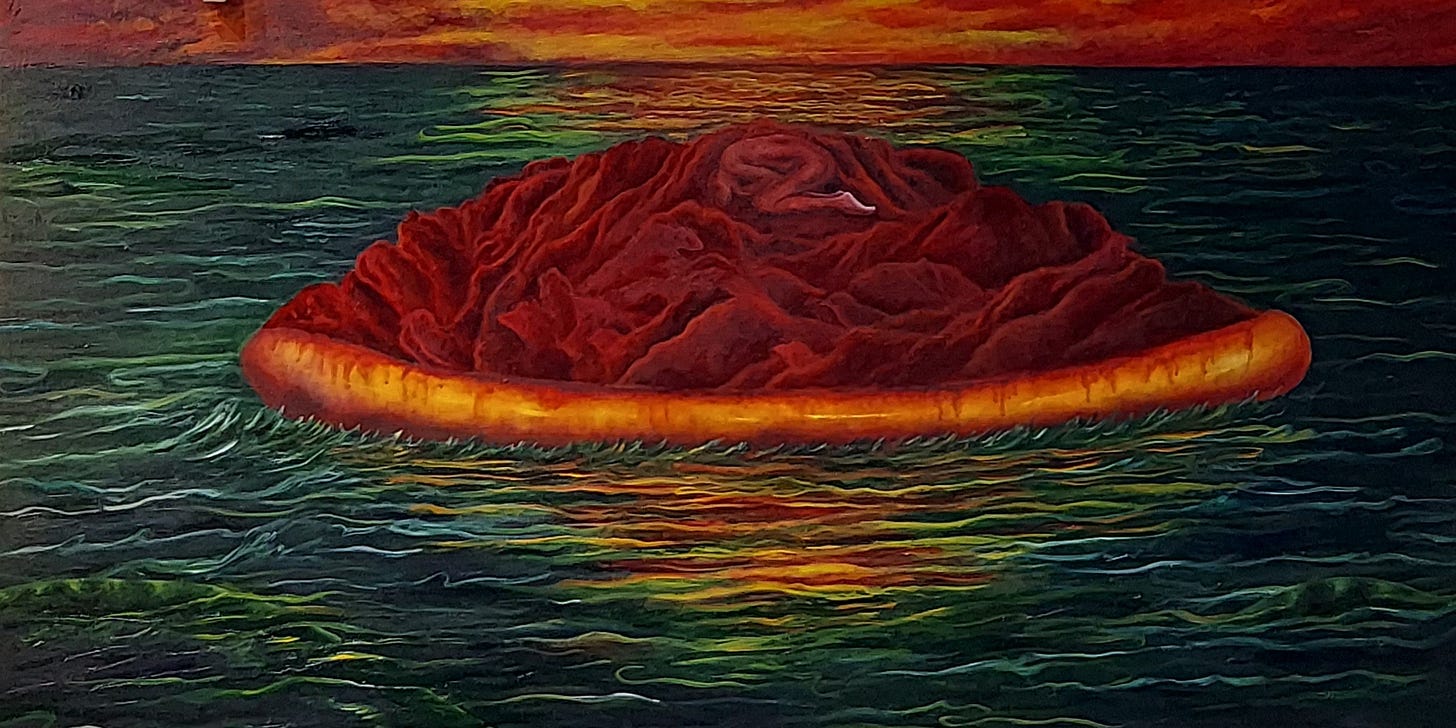Jacqueline Bishop at Arthur Roger Gallery, New Orleans
A conversation with New Orleans-based artist Jacqueline Bishop.
(Jacqueline Bishop, To Surrender, 2023-24, oil on Belgian linen, 24 x 26 inches)
Welcome to my conversation with New Orleans-based artist Jacqueline Bishop. Her upcoming exhibit Anthology: The Gathering of Flowers, a dramatic collection of new and recent paintings and works on paper, all imbued with alizarin crimson, will be on view at Arthur Roger Gallery, located at 432 Julia Street, from December 7, 2024, through January 18, 2025. The exhibition is Bishop’s ninth at Arthur Roger Gallery and comes after a six-year pandemic-related pause, when New Orleans, like many other cities, temporarily shut down, and Bishop took on the role of caregiver for her husband, Herbert Daniel Halpern. (Known as “the textile guru,” Halpern operated Promenade Fine Fabrics on St. Charles Avenue and worked to protect the city’s public and private trees and greenery. He was diagnosed with a brain tumor in March 2020 and passed September 1 of this year.)
In Greek, “anthology” translates to “flower gathering” or collecting, and the title of the exhibit refers to nature’s resilience in the wake of manmade ecological abuse and destruction. Such resilience is also apparent in Bishop, who has lived in New Orleans for 50 years and traveled into Third World countries and the Amazon jungle to research and witness with her own eyes evidence of eco-political injustices and other crimes. In 1999, she published Em Memória Chico Mendes, a collection of essays and images of Bishop’s paintings honoring the legacy of Chico Mendes, a Brazilian rubber tapper (or seringueiro), environmentalist, and human rights advocate, who was assassinated on December 22, 1988. (The book was published in English, Spanish, and Portuguese.) Bishop’s lifelong commitment to her practice and principles (she has been making art steadily since childhood) is all the more laudable when one considers how often women have been systematically erased from art history. She has since exhibited and lectured through the Americas, Asia, and Europe, and her work can be found in the permanent collections of the New Orleans Museum of Art, the Ogden Museum of Southern Art, the Detroit Institute of the Arts, and the Minneapolis Institute of Arts, as well as many other public and private collections.
In 1999, when I lived in New Orleans, Jacqueline asked me to create a prerecorded score of sound and music to accompany her mixed-media installation Terra (1986-2002), a 60 x 3-foot wall memorial consisting of hundreds of small bird portraits, natural objects, drawings, and collages arranged to create a single landscape. My recording of that score, 200 Birds, features performances by mezzo-soprano Lainie Diamond, percussionist Chris Michael, and guitarist Lynn Wright.
(“The Heart of the Forest” from 200 Birds.)
Jacqueline and I have stayed in touch ever since, and reconnecting with her for this interview has been a pleasure. Although, it feels like there’s still so much to discuss.
This conversation took place via email, phone, and Zoom, and reminded me that I really need to visit New Orleans soon.
(Jacqueline Bishop; photo by Elizabeth Perrin)
Are the paintings in Anthology: The Gathering of Flowers works you did during the pandemic?
My last show at Arthur Roger Gallery was in 2018. I show every three years there. And then the pandemic came in 2020, and my show was canceled. So I’ve been working on this show for six years. I worked right up until recently. There are 23 pieces in the show, including one with a sculptor, MaPo Kinnord.
Do you ever take a break from painting?
I don’t take too many breaks; I work seven days a week in the studio. But I do other things too. I’m not teaching anymore, I’m not doing the radio work. I just try to read and help with my husband’s business, which is just three hours in the morning. (I took care of my husband Herbert for four years, and he passed September 1, 2024.) The rest of the time, I’m in the studio. And I have a Mississippi studio too where I can go and work.
So, I guess I don’t take too many breaks!
Where were you born?
I was born in Southern California, in Long Beach.
Do you remember the first piece of art that sort of hit you, resonated with you, and maybe even was a sign that this is something you would want to do with your life?
We were living in Kansas City, MO. I was ten or eleven years old, and somehow, I was dropped off at the Nelson-Atkins Museum of Art, which is the most incredible museum. I walked into this room where the contemporary paintings are, and saw a huge painting by James Rosenquist. I was floored by the scale and the subject matter — I relate to imagery. And I think I said, to whoever I was with, “I can do that!”
The following year in junior high, an art teacher asked if anyone would like to take private drawing lessons. Five of us in a big class raised our hands. So I went home and asked my parents if I could do it. They scraped up the money, and yes, I took those private lessons. The art teacher took all five of us in her small, MGB sports car with the top down, and drove to her little apartment. She had us in her tiny kitchen, where a lamp came down from the ceiling. She turned it on above all of these cylinders and geometric shapes made out of white paper, and we had to figure out what light was, and what dark was. Well, that changed my life.
I took art all through high school, including art history in my freshman year, and everyone I studied with was a woman. They were always very, very encouraging. I had all my credits done early, so in my senior year, I was able to graduate early and go to college, or I could take the rest of the time and just have all art classes. So, I became the art teacher’s assistant and had four hours straight of art, and in that class, we did everything. We did silversmithing, mosaics, we had models for drawing; we did painting, jewelry making, macramé, there was a potters’ wheel, — you name it, we did it. I was exposed to everything you can think of, including sniffing glue in the storage room. (laughs) We took turns! We were very adventurous, little hippie artists.
Going back to when I was in Kindergarten, my art teachers were all women. But then, when I got to college, there were no women, and it was a completely different experience. And then there was H.W. Janson’s book History of Art that we had to study, which had no women or people of color in it. That was a very, very thick book, and it was a standard college textbook.
That must have been shocking. Before college, were you exposed to art made by women?
I didn’t really know any. My grandmother was a “closet” painter. Nobody knew she painted until she died, and they found her paintings in a little closet. If I knew any women artists, they weren’t taken seriously. It wasn’t like they were making money from their art.
When I had my first show as a freshman in high school at a shopping center in the middle of a mall, I sold a couple of paintings, and I said, “Wow! I get paid for this?” When I found out James Rosenquist made money for that big painting, I said, “People actually get paid to make paintings? I’ll do it for free!” (laughs) That changed!
Were your parents supportive of your vocation, and the direction you were taking?
Oh, absolutely. They were both creatives in their own way and worked with their hands. One Christmas, my father got me an easel, and my first studio, at the age of 15, was up in the attic. That’s where I would hide after everybody went to bed, paint two or three hours a night, get a few hours of sleep, and then get up and go to school. That’s how I lived. And I’m doing the same thing as I always have.
Can you describe what you were painting as a teenager? Was it abstract?
I have never painted abstract. I’m too much of an imagist. I was painting imagery, figurative, and still life in a Van Gogh style. It was expressionistic but with more detail. And it just became more and more refined over the years.
(Jacqueline Bishop, From Sea to Shining Sea, 2022, oil on linen, 24 x 26 inches)
Do your paintings begin with sketches, photographs, or other forms of pre-planning and experimentation?
I fill up sketchbooks with quick drawings in pencil or pen and written words describing my visions. I refer to the sketchbooks over time. I also take photos and collect photos for reference.
Early in your career, you experienced some pushback regarding the subject matter you began exploring, specifically ecological abuses in your part of the world, the Deep South, and in Third World countries. You were told this might impact your sales. But it seems that in our time, galleries, museums, and collectors are more open to the kind of work you helped to pioneer. Is that accurate?
It still depends. It depends on who’s buying it. Will an oil tycoon buy my work? I don’t think so. Even though they might support one of the institutions and have their name on the side of the building, doesn’t mean that they care about those issues.
Some people feel my work is too political, in that direction. But it’s not heavy, in your face, and about shock value, because I like to have the poetry and the politics together. I like it more subtle.
So yes, there is more acceptance of sustainability thinking, but it’s not enough.
I would think owning a Jacqueline Bishop painting and installing it in your home is making a statement. It’s not about interior decorating.
It’s not about decoration. If that’s was I was making, I think I would stop.
(200 Birds CD cover; bird portrait from Terra by Jacquline Bishop)
So many species of birds are present in your work. I believe you once described birds as “prophets.” Am I correct?
I might have said that. Birds are so many things for me. They are prophets because they have the information.
We’re talking about birds, not in a symbolic sense, but actual birds you have encountered in your travels.
Right. And since birds travel, they see what’s happening to the landscape. When they migrate, if they are migrating birds, they see these changes. If they are used to taking a long migration, by the time they arrive in the United States say from Brazil, they’ve lost so much weight it’s almost hard to identify the species because they’re a different shape. They are hungry, thirsty, and exhausted from the trip. But when they’re looking for their water hole which they’re used to landing on every year after migration and it’s not there, that can be the beginning of the extinction process.
Have you witnessed what you’re describing in person?
Yes. In Cameron Parish, I was with the bird watchers with the Louisiana Ornithological Society in October 2004, when the birds first came in from South America. I did not recognize a rose-breasted grosbeak. It was so thin (when it arrived), and I couldn’t see the colors. It didn’t look like a grosbeak, except for the beak. And then when the birds fall from the air — it’s called the “fall out” — they fall to the ground from exhaustion, looking for that water hole. I saw them do this before Hurricane Katrina, and it was just magical. But after Katrina, the water hole was destroyed, and I don’t know what happened with the next migration. I didn’t go back to Cameron Parish that year because it was pretty much destroyed after the hurricane.
Your birds, like those in Terra, have a lot of character. There’s something behind their eyes, in your paintings.
Most of those birds in Terra are scientifically correct. But nothing in my work is exactly indigenous to a region. I create imaginary worlds inspired by real issues. I like to have my liberties and to experiment with maybe adding another species to one species, which would be a sub-species of a sub-species, which is happening with some animals and birds. It’s part of their adaptation.
I consider birds as the soul of the world. They should have our conscious awareness. Because without them, what are we going to do? And other species too, like bats and bees — the pollinators of our fruits. We wouldn’t have apples if it weren’t for these little creatures. People take this for granted.
I like the whole concept of ecology, and its role in our survival and its role even if we humans weren’t here. It’s a natural system.
And that system can be disrupted.
It has been disrupted.
(Jacqueline Bishop, Undocumented, 2022, oil on Belgian linen, 24 1/4 x 49 1/2 inches)
I imagine your first visit to a rainforest was life-changing. Where was the forest located, and how did exploring it impact your work?
My first visit to a rainforest was in 1975 in the Dominican Republic. I was 19. There was a construction company removing the forest for development, so I didn't explore inside the forest. The next time was in 1991 in the Brazilian Amazon where the forest was so vast that it seemed to cover the entire world. The quiet in the forest combined with the haunting call of the Screaming Piha will forever linger in my memory. After a couple of weeks of camping in the forest, the natural system of the trees, wildlife, and insects was so powerful that it seemed to control the direction of my own blood flow.
Can you talk about your current relationship with the culture of New Orleans?
I don’t know where else I’d live if I left New Orleans. I love it. I’ve been here for 50 years. More than half of my life. I sat on the board of the Contemporary Arts Center for five-and-a-half years and founded the program, Art Speak, which I organized as a volunteer board member. I hosted my own radio program on WWNO, an NPR affiliate, called Louisiana Artists. I taught a class called Art and the Environment at Loyola and Tulane, but I’m not teaching anymore. These days, I’m more involved with making the work now than I am volunteering my time. I do sit on the board of the Newcomb Art Museum of Tulane. But right now, I’m really just a studio artist and a lecturer.
When Mardi Gras happens, do you get out of town?
I go to Mississippi or stay in my studio. I might go to a couple of parades and parties, but it’s not an every-night thing for me.
How about the food? Do you have favorite dishes or favorite restaurants?
You better believe it. (laughs) I really don’t know where to begin . . . I tend to go more toward French Creole, and then there’s the traditional, along with the younger chefs coming up who are very experimental. It’s amazing what’s happening here!
The history of New Orleans is very rich.
Is it true that for 40 years, Allen Toussaint wore your husband Herbert’s designer brocades for stage performances?
Yes! They were friends for over 40 years. Allen Toussaint liked really nice brocades with metallics, so it would be Channel, Carolina Herrera, that kind of thing, and Herbert had that in his high couture fabric store on St. Charles Avenue. Allen would have tuxedos or suits made out of these beautiful metallic brocades from France or Italy, and he’d still have on his sandals. (laughs) With white socks!
Have these fabrics from around the world, the colors and patterns, informed your paintings a bit?
Oh, absolutely! Especially the whole concept of draping and the resulting light and texture, and prints and patterns, of course.
But as far as color, I tend to go toward the source. In this show, there are 23 paintings in alizarin crimson. It’s what the Egyptians used 3,000 years ago in their murals in paintings depicting their culture. They used it in their textiles, and that connection resonates with me. But I also use it as the color of methane. Methane doesn’t have a color until it hits the air and then it’s red, then turns blue, whereas alizarin crimson is red with a blue undertone. It’s just fascinating how methane and alizarin crimson connect color-wise. I love poetic connections like that.








Wonderful interview! Thank you.